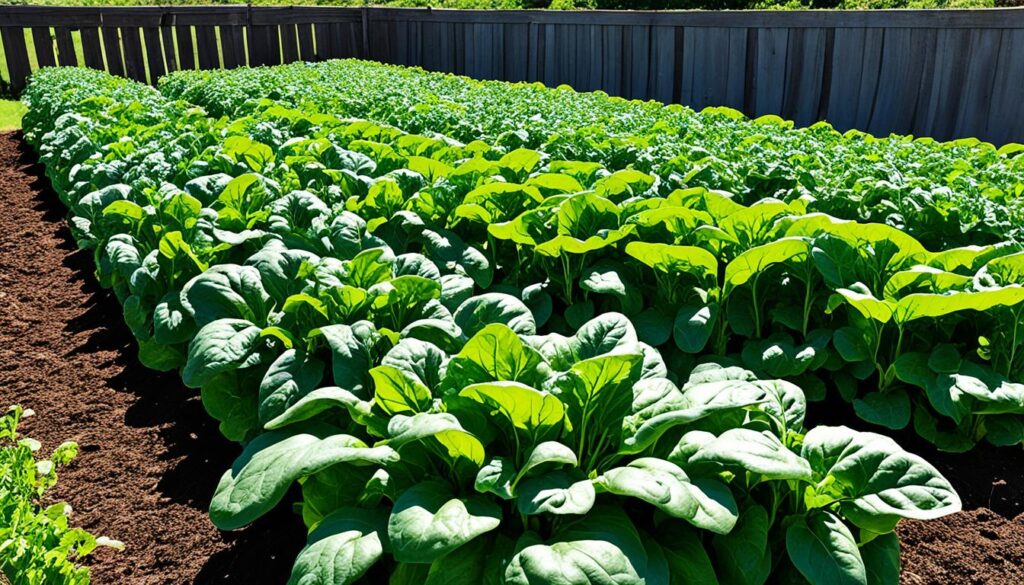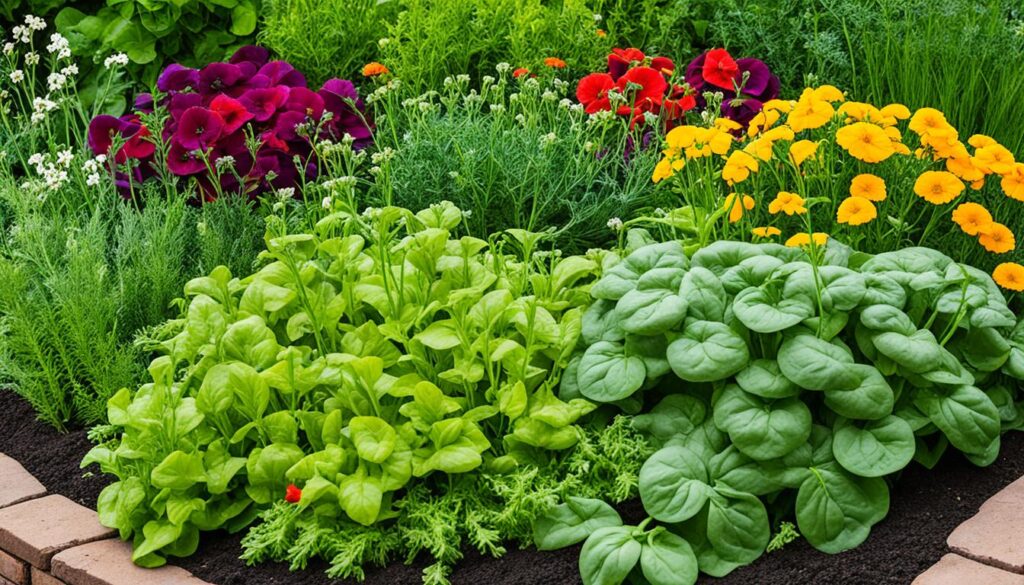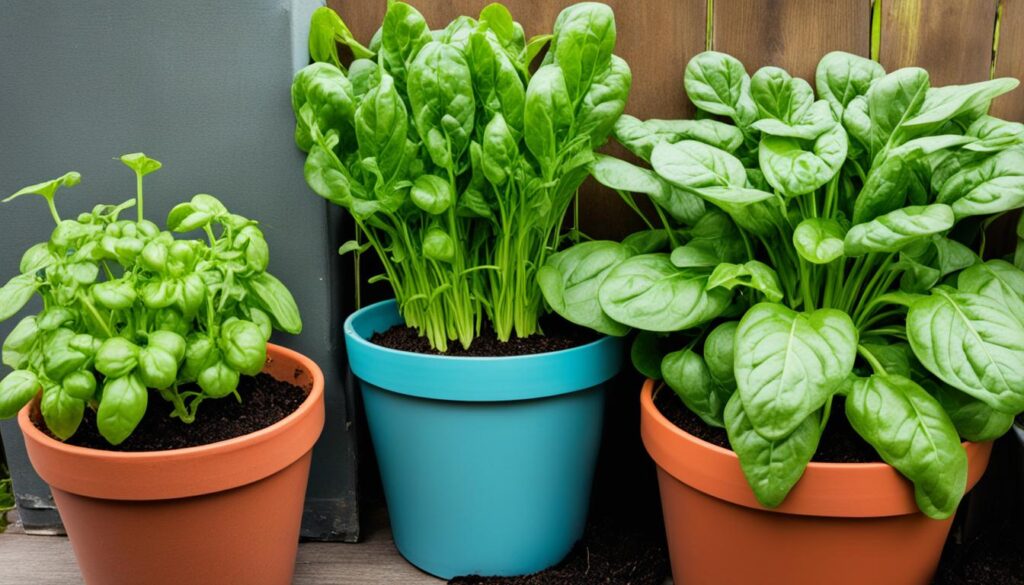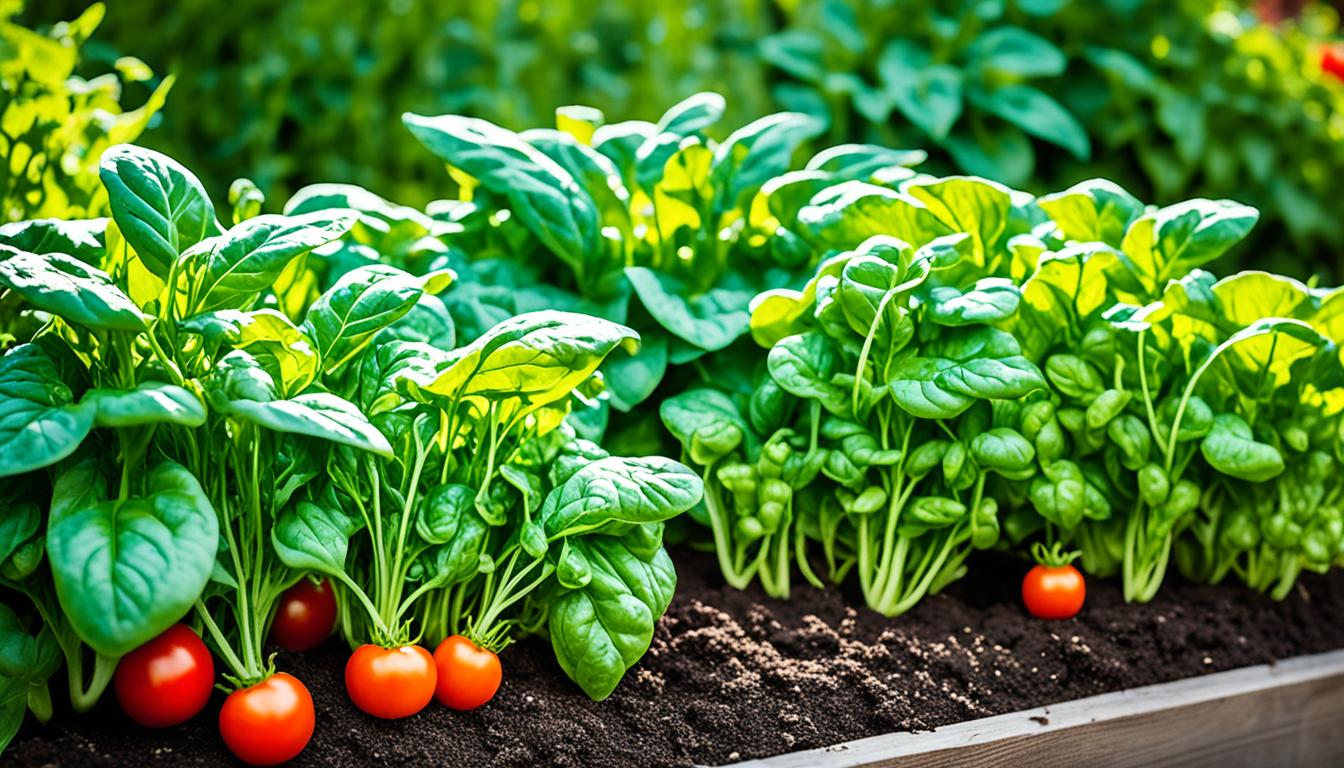As I step into my garden, I first notice my spinach. Its lush green leaves stand out. They are full of vitamins, minerals, and antioxidants. This makes them a key ingredient in my family’s meals.
Spinach is not just healthy, it also grows well with other plants. Pairing it with certain plants can boost its growth. This is what we will talk about today. We will see how spinach and tomatoes benefit each other when planted together.
Key Takeaways
- Spinach is a fast-growing, resilient crop that can thrive with the right companion plants.
- Companion planting can help repel pests, attract beneficial insects, and provide valuable shade for spinach.
- Certain vegetable and herb pairings, like spinach and tomatoes, can enhance the flavor and productivity of both crops.
- Companion planting maximizes garden space and minimizes the need for chemical interventions.
- Exploring the world of companion planting can lead to a more vibrant, productive, and sustainable home garden.
The Benefits of Companion Planting
Companion planting teams up certain plants to make a garden thrive naturally. It’s an old method that boosts plant growth and fights pests. By planting together, crops support each other. This reduces the need for harmful chemicals. The result is healthier plants and a lively garden.
Repelling Insect Pests
One big pro of companion planting is chasing away bugs. Some plants, like garlic, smell bad to pests. So, if you arrange these stinky friends around, they shield your plants.
Deterring Animal Foragers
It’s not only bugs that stay away. Bigger threats like rabbits and deer can also be deterred. The “Three Sisters” method mixes corn, beans, and squash to create a barrier. This confuses animals. Giant plants like sunflowers tower over smaller ones for extra protection.
Attracting Predatory Insects
Growing certain plants can draw in helpful bugs. These include ladybugs and parasitic wasps that eat garden pests. Adding colorful flowers can invite them over. Then, they keep the bad bugs in line without chemicals.
Attracting Pollinators
Bees, butterflies, and hummingbirds are critical for many plants to produce fruit or seeds. Adding flowers to your garden can bring them in. This means more fruit and seeds for you. Research shows this can boost their numbers by 30%.
Preventing Crop Diseases
Some plants can fight off diseases to help their neighbors. Marigolds stop nematodes, and oregano fights off bugs and mold. With these plants around, your garden is protected. This makes for a healthier garden without using harsh chemicals.
Enhancing Crop Flavor
Not only does companion planting help your garden grow more, but it makes food taste better too. Herbs and flowers like basil, oregano, and marigolds can make your produce more delicious. This adds flavor to your cooking and makes the garden smell wonderful.
Using companion planting, your garden can be a place full of life. It’s good for every kind of gardener. These plant teams can work wonders in your garden. They create a beautiful, natural space that thrives without harmful chemicals.
Spinach and Tomato Companion Planting
Spinach and tomatoes are great together in the garden. They not only do well side by side but also help each other out. Together, they boost your garden’s health and yield.
The main benefit of pairing them is the shade protection tomatoes give spinach. Spinach hates hot weather and may start sending up flower stalks too soon. The tall tomatoes provide shade, keeping the spinach cool and delaying the flower stalks.
They also have a symbiotic relationship that balances nutrients. Spinach’s shallow roots don’t interfere with the deep tomato roots. Both plants can use the same soil well, getting the needed nutrients and water without a fight.
| Benefit | Explanation |
|---|---|
| Shade Protection | Tomato plants provide much-needed shade to protect spinach from bolting in warm weather. |
| Nutrient Balance | Spinach’s shallow roots don’t compete with the deep-rooting tomato plants for soil nutrients and water. |
| Complementary Growing Seasons | Spinach’s cool-weather preferences complement tomatoes’ heat-loving nature, allowing gardeners to maximize their growing space and extend the seasons for both crops. |
The complementary growing seasons also benefit gardeners. Spinach likes it cool, while tomatoes love the heat. By growing them together, you make the best use of your garden space. You can plant two crops in the same area and enjoy fresh veggies for longer.
In the end, the teamwork between spinach and tomatoes is a big win. Together, they offer many advantages for your garden. Mixing these two veggies helps your garden grow and produce better. It’s a smart way to manage your garden’s space and resources.

“Companion planting is a gardening technique that involves growing different plants together for their mutual benefit, such as improved growth, pest control, and nutrient balance.”
Companion Planting with Vegetables
Spinach does well with other veggies. Choosing the right mates can boost garden space and soil health. It also helps keep pests away, leading to a big, healthy spinach harvest.
Sugar Snap Peas and Spinach
Sugar snap peas and spinach are a great team. The peas add important nutrients to the soil. Their vines also offer shade, which spinach loves, to prevent it from bolting.
Kale and Spinach
Kale and spinach make a top pairing. Kale’s leaves shield the spinach and its roots improve soil. This mix helps spinach grow strong.
Swiss Chard and Spinach
Swiss chard and spinach thrive together due to similar needs. Planted side by side, they help each other grow. This method uses garden space efficiently.
“Companion planting is a great way to create a diverse, thriving garden ecosystem, and spinach pairs beautifully with a variety of vegetables.”
Pairing spinach right offers many garden benefits. This includes a richer soil, saving space, controlling pests, and protecting crops with some shade. With the right companions, a spinach garden can flourish.
Companion Planting with Flowers and Herbs
Companion planting means putting certain plants together to make a better garden. Your spinach can grow better with the right flowers and herbs around. They help your spinach and make your garden look pretty too.
Marigolds and Spinach
Marigolds have a strong smell that keeps bugs away from your spinach. They protect it from aphids, nematodes, and bigger pests like rabbits and deer by acting as a shield. Marigolds also fool bugs into eating them instead of your spinach.
Borage and Tomatoes
Borage, a herb that flowers, is great for tomatoes. It attracts bees and other good bugs that help tomatoes grow. Tomatoes even taste better when borage is nearby, showing how well they work together.
Adding certain flowers and herbs to your spinach area makes it a better place for all plants. This mix helps spinach grow strong. It also brings good bugs, keeps bad bugs away, and shows why working together makes a garden better.

“Companion planting is a time-honored gardening technique that can greatly benefit the health and productivity of your spinach crop, all while adding a touch of natural beauty to your garden.”
Maximizing Garden Space
Companion planting is a great way to use your garden better, especially in small spaces. It means combining plants that help each other. This way, you can grow more in a small area. Techniques like raised beds and packing plants closely together make this even more effective, especially for spinach.
One big plus of companion planting is how it lets you use space smartly. For example, planting radishes with carrots can double your plant count in one area. This means your garden works harder, even if it’s small.
Companion planting also lets you use the air space above your garden. By planting vining crops like cucumbers or pole beans to grow up, you save room for other plants below. This helps in upping your garden’s output without taking more ground space.
| Companion Planting Technique | Benefits |
|---|---|
| Intercropping | Grow more plants in the same space by planting early and late-maturing crops together |
| Vertical Gardening | Utilize upright space for vining crops, freeing up ground-level area for leafy greens |
| Raised Bed Gardening | Concentrate nutrients and improve drainage in a compact footprint |
| Intensive Planting | Maximize the number of plants per square foot without overcrowding |
Whether you’ve got a small yard or a little balcony, companion planting can work wonders. It lets you make the most of your space. With the right plants and these techniques, you can have a lush, productive garden.
“Companion planting is a game-changer for small-space gardeners. It allows you to grow more in less area, while also creating a healthier, more vibrant ecosystem.”
Considerations for Successful Companion Planting
Companion planting helps in many ways, like keeping pests away and making plants taste better. But for your garden to really bloom, you need to think about a few things. This includes choosing plants that work well together, making sure they have the right space and grow at the same pace, and understanding what they need in terms of light, shade, nutrients, and water.
When you pick companion plants, think about how they grow, how much light they need, and what they eat. Some plants take the same things from the soil or water, but others help each other out. This is a smart way to make your garden do better without needing extra help.
How you arrange and when you plant your garden matters a lot. Plants shouldn’t get in each other’s way as they grow. Also, you want them to grow together well. This means, making sure they don’t block each other’s sunlight or grow much faster than the others.
Nature gave each plant its own likes. This means some like sunny spots and some prefer the shade. Plus, some need a lot of nutrients, while others are happy with less. By knowing what each plant likes, you can make a garden where they all help each other grow strong and healthy.
With the right care and thoughts behind it, companion planting can really make your garden flourish. Be sure to check out companion planting guidelines and plant compatibility, and learn more about spacing and timing, as well as plants’ needs for sun, shade, nutrients, and water. These things are key to making your garden a success.

“Companion planting is not an exact science, and successful companionships could vary by location. Experimentation and observation are key to finding the perfect pairings for your garden.”
Conclusion
I love gardening, especially because of spinach and tomato companion planting. It makes my garden healthier and more productive. This method also keeps my garden natural and able to fight off problems on its own. I choose plants that work well together, look after them properly, and think about their needs. This way, my spinach grows really well, and I get a lot of it without much work.
The idea of companion planting has changed my garden for the better. I use it to keep away bugs and animals and to make my veggies taste better. There are many ways to do companion planting, like mixing plants and placing them strategically. Because of this, my garden is not just pretty but also produces a lot and can face challenges well.
Looking ahead, I can’t wait to see what else I can do with my vegetable garden. I’m going to keep using companion planting, organic farming, and sustainable agriculture. These practices make my garden like a little natural community. I believe I can keep growing great spinach and tomatoes in the years to come.
FAQ about Spinach and Tomato Companion Planting
What are the benefits of companion planting for spinach?
Companion planting helps spinach in many ways. It keeps harmful bugs away and stops animals from eating it. It also brings good bugs and bees to your garden. This makes spinach grow better.
How can spinach and tomatoes be companion planted?
Spinach and tomatoes make great garden friends. Tomatoes give shade that helps spinach in hot weather. Their different needs mean they don’t compete for space. Together, they make your garden more productive.
What other vegetables can be companion planted with spinach?
Spinach goes well with sugar snap peas, kale, and Swiss chard. Sugar snap peas add nutrients to the soil and shade for spinach. Kale’s leaves protect from sun and its roots help the soil. Swiss chard makes better use of your garden area and helps the soil too.
How can flowers and herbs be used as companion plants for spinach?
Marigolds keep harmful bugs away from spinach with their smell. Borage attracts bees that help all your plants grow better. These friends of spinach make your garden more diverse and strong.
What factors should be considered for successful companion planting with spinach?
It’s important to pick plants that work well together. They should need similar amounts of sun and water. The right space and time for planting are key. This keeps all your plants healthy and happy.
Source Links
- 28 Spinach Companion Plants To Grow With Spinach
- Companion Planting
- Companion Planting Guide | First Tunnels
- The Science of Companion Planting
- Extension | Companion Planting
- Companion Planting Booklet
- Spinach companion plants – the best vegetables, herbs and flowers to grow alongside spinach
- 14 Best Spinach Companion Plants (And Some To Avoid!)| Boreal Bloom Homestead
- Companion Planting For Spinach
- Companion Planting Chart and Guide for Vegetable Gardens
- Use Our Companion Planting Chart to Grow a Thriving Vegetable Garden
- 10 Best Spinach Companion Plants for Natural Pest Control
- Companion planting in home gardens
- 16 Best Spinach Companion Plants + 6 to Avoid
- Companion Planting Guide: Maximizing Vegetable Garden Space and Productivity
- Companion planting: Which vegetables to use? – Sara’s Kitchen Garden
- Companion Planting Guide with Chart! – Wilco Farm Stores
- A Practical Guide to Successful Companion Planting with Tomatoes
- The Comprehensive Guide to Companion Planting
- What Is the Best Companion Plant for Tomatoes: Enhancing Growth and Flavor – Forestry.com
